#RF Antenna Module
Explore tagged Tumblr posts
Text
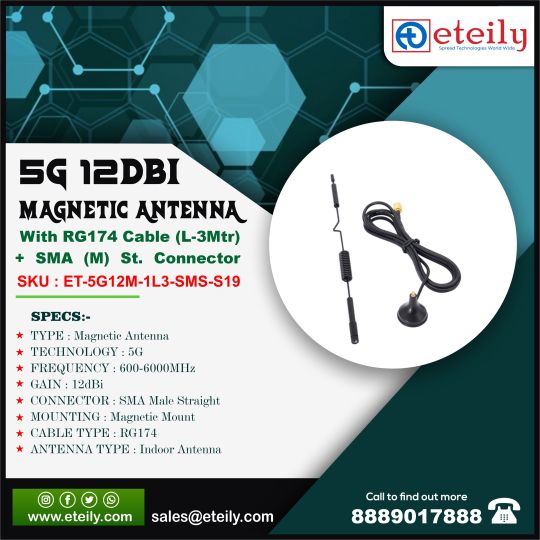
5G 12dBi Magnetic Antenna with RG174 Cable
A 5G 12dBi magnetic antenna is a type of antenna designed to enhance the performance of 5G wireless communication devices, such as routers, hotspots, or modems. Let's break down the key features:
5G: 5G is the fifth generation of wireless technology, which offers faster data speeds, lower latency, and greater capacity compared to previous generations (4G, 3G, etc.). The antenna is specifically designed to work with 5G networks and devices.
12dBi Gain: The "12dBi" figure refers to the antenna's gain, which is a measure of how much the antenna can increase the power of the signal it receives or transmits. A higher gain indicates better signal reception and transmission capabilities. In this case, a 12dBi gain suggests that this antenna can significantly boost the signal strength.
Magnetic Antenna: The term "Magnetic Antenna" indicates that the antenna can be attached to metal surfaces using a magnetic base. This feature provides flexibility in terms of placement and allows for easy positioning on metallic surfaces, like the roof of a car or a metal housing for a 5G device.
Magnetic antennas are often used in mobile applications or in scenarios where temporary or flexible mounting is required. This type of antenna is convenient because it can be easily installed and removed, making it suitable for mobile installations or where drilling holes or more permanent mounting solutions are not practical.
#rf antenna#RF Antennas#RF Antenna at Best Price in India#RF antenna system#radio frequency antenna#Best RF Solution Provider#RF Antenna Suppliers#Manufacturer of RF Antenna#rf antenna manufacturers in india#RF Antenna Manufacturer#RF Antenna Exporters#RF Antenna Latest Price#Wireless HF Antenna#RF Antenna Companies in India#Wholesaler of RF Antenna#RF Antenna Amplifier#RF Antenna Module#2.45 GHz Antenna Module#High Performance RF#Antennas for LoRa and Sigfox#Omni-directional SMD antennas#3.3GHz RF Antennas#RF & Microwave Antenna Manufacturers#Antenna manufacturers in Canada#RF Antenna manufacturers & suppliers - India#RF Antenna made in India#India telecom rf antenna#2.4ghz & 5ghz antenna#multiband antenna#telecom rf antenna products
0 notes
Text


sickest band merch ever
#i need to either get a standalone vhs player or a better way of transmitting signals than a rf modulator on an amplified tv antenna#so i can put this on my big crt
2 notes
·
View notes
Text
youtube
Panasonic: New Product Introduction: PAN1770 Series Bluetooth Low Energy RF Module
https://www.futureelectronics.com/m/panasonic . Panasonic PAN1770 Series is based on the Nordic nRF52840 single-chip controller that allows you to attach an external antenna via uFL. With the Cortex®-M4F processor, 256 kB RAM, and the built-in 1 MB flash memory, the PAN1770 Series can easily be used in standalone mode, eliminating the need for an external processor saving complexity, space, and cost. https://youtu.be/8Ur-bFMieHw
#Panasonic#PAN1770#Bluetooth Low Energy#RF Module#Nordic nRF52840#single-chip controller#external antenna#uFL#Bluetooth 5.3#LE 2M PHY#LE-coded PHY#Cortex-M4F processor#256 kB RAM#Panasonic single-chip controller#Youtube
0 notes
Text







Twin Famicom
NES with internal Disk system from Sharp
The Twin Famicom is a video game console system that was produced by Sharp Corporation in 1986 (Juli 1) and was only released in Japan. It is a licensed Nintendo product that combines the Famicom (NES) and the Famicom Disk System into a single piece of hardware.
The essential parts of the Twin Famicom include a 60-pin socket for Famicom cartridges and a socket for Disk System disks. The player could switch between the two media types with a switch – cassette "カセット" or disk "ディスク" The Twin Famicom is fully compatible with the NES and can handle accessories made for the NES (e.g. Beam Gun). But there is also an extra port on the Twin Famicom. This allows a 'regular' Famicom to use the Twin Famicom's disk drive.
The original Famicom only has one color combination, and the Twin Famicom was initially sold in two colors: red with black highlights (AN-500R), and black with red highlights (AN-500B). A second version of the system was released in 1987 with a slightly different case design, turbo controllers, and two different color schemes; black with green highlights (AN-505-BK) and red with beige highlights (AN-505-RD).
Like the Famicom, the Twin Famicom uses NTSC but with an AV output rather than an RF modulator with an RCA connector for composite video and mono audio, allowing for greater audiovisual quality on TVs and monitors with such inputs. An external RF modulator is bundled with the unit for connection through a TV's antenna/cable input. The two gamepads are hardwired into the console, so they cannot be disconnected.
More info:
https://ultimatepopculture.fandom.com/wiki/Twin_Famicom
#nintendo#famicom#twin famicom#sharp#nintendo disk system#retrogaming#retro gaming#nes#retro computing#retrocomputing#80s#80s computer#japan only
19 notes
·
View notes
Text
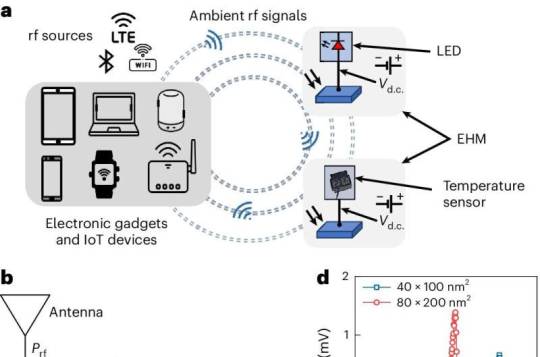
Battery-free technology can power electronic devices using ambient radiofrequency signals
Ubiquitous wireless technologies like Wi-Fi, Bluetooth, and 5G rely on radio frequency (RF) signals to send and receive data. A new prototype of an energy harvesting module—developed by a team led by scientists from the National University of Singapore (NUS)—can now convert ambient or "waste" RF signals into direct current (DC) voltage. This can be used to power small electronic devices without the use of batteries. RF energy harvesting technologies, such as this, are essential as they reduce battery dependency, extend device lifetimes, minimize environmental impact, and enhance the feasibility of wireless sensor networks and IoT devices in remote areas where frequent battery replacement is impractical. However, RF energy harvesting technologies face challenges due to low ambient RF signal power (typically less than -20 dBm), where current rectifier technology either fails to operate or exhibits a low RF-to-DC conversion efficiency. While improving antenna efficiency and impedance matching can enhance performance, this also increases on-chip size, presenting obstacles to integration and miniaturization.
Read more.
43 notes
·
View notes
Text

A mini GPS from uBlox with I2C and UART 🛰️📡🔧
The SAM-M8Q
is an entry-level 'all in one' GPS from uBlox - it comes with both UART and I2C interfaces plus a built-in antenna so it's ready to go 'out of the box.' It's also fairly small, so we decided to try and make a little breakout for it. It exposes both interfaces, but we expect most folks will like using the Stemma QT port for instant I2C interfacing. We gotta dig into uBlox's interface since we expect the I2C to be a little more complex than the PA1010 we've used.
#adafruit#gps#ublox#i2c#uart#sam-m8q#stemma#pa1010#electronics#gpsmodule#makerspace#hardwaredesign#embedded#opensourcetools#diyprojects#techinnovation#electronicsprojects#gpsbreakout#prototyping#smalldevices#sensorintegration#microcontroller#makersmovement
7 notes
·
View notes
Text
HDMI RF: The Little Prince of Signals
On Asteroid AV-612, where coaxial vines coil like sleepy serpents and screens glow like captive stars, lives a lonely modulator. Its name is HDMI RF, and its magic turns digital whispers into analog constellations—forging bonds between ancient TVs and modern worlds. Let’s wander its universe, where 4K dreams dance on CRT skies.

1. The Modulator’s Tiny Planet
HDMI RF tends its garden:
RG59 Vines: Stretches signals 500m—far enough to touch factory robots and hospital screens across cosmic dust.
Channel Flowers: Blooms 80+ frequencies, each a color for grandma’s CRT or a surgeon’s monitor.
Frostfire Heart: Works -10°C to 45°C, smiling as Siberian snowflakes melt on its circuits.
Why USB-C’s asteroid fails: “Too busy chasing wireless comets to root in copper soil.”
2. Journey to Strange Planets
🌍 Planet of the Factory Golems: “Why do sparks fly?” asked the Prince. “To light the path for welding robots,” HDMI RF replied, coaxing 4K feeds through gremlin storms.
📺 Planet of the CRT Rose: An old TV sighed: “New streams forget me.” HDMI RF touched her screen—Stranger Things bloomed in 480i petals. “What’s obsolete is just lonely.”
🏥 Planet of Healing Scry-Glass: Guarded MRI screens from Wi-Fi ghosts. “Chaos fears a steady signal,” it hummed, syncing heartbeats.

3. The Fox’s Wisdom
“Tame me,” begged a flickering screen. HDMI RF shook its head: “My magic needs no Wi-Fi. Just trust—and RG59 cables.”
4. The Businessman’s Streaming Empire
“I beam 8K through air!” boasted a satellite. HDMI RF watched a village antenna dance: “Your sky-signals fade. My copper vines? Eternal.”
5. Where Stars Still Sing
Rural Villages: Children gather ’round antennas, HDMI RF turning one Netflix stream into 48 constellations.
Retro Arcades: GoldenEye 007 glows on tube TVs, unbroken as the Prince’s promise to his rose.
Factory Floors: Robot diagnostics pulse down 500m cables—sparks bowing to the modulator’s spell.
Epilogue: The Signal’s Secret As rockets chase thinner streams, Asteroid AV-612 glows gold. For what truly connects worlds isn’t speed—it’s the magic to speak every screen’s language.
1 note
·
View note
Text
I saw @pc-98s do this and I had to try it for myself, can confirm it's very cool
(I forgot to add context that this is being streamed via an rf modulator through an antenna to the tv)
The girlies all together

(I forgot to turn oscilloscope for the photo lol)
23 notes
·
View notes
Text
Best Partner for Wireless Modules: A Comprehensive Antenna Selection Guide
n the field of wireless communication, antenna selection is crucial. It not only affects the coverage range and transmission quality of signals but also directly relates to the overall performance of the system. Among various wireless modules, finding the right antenna can maximize their potential, ensuring stable and efficient data transmission.
When designing wireless transceiver devices for RF systems, antenna design and selection are essential components. A high-quality antenna system can ensure optimal communication distances. Typically, the size of antennas of the same type is proportional to the wavelength of the RF signal; as signal strength increases, the number of required antennas also grows.
Antennae can be categorized as internal or external based on their installation location. Internal antennas are installed within the device, while external antennas are mounted outside.
In situations where space is limited or there are multiple frequency bands, antenna design becomes more complex. External antennas are usually standard products, allowing users to simply select the required frequency band without needing additional tuning, making them convenient and easy to use.
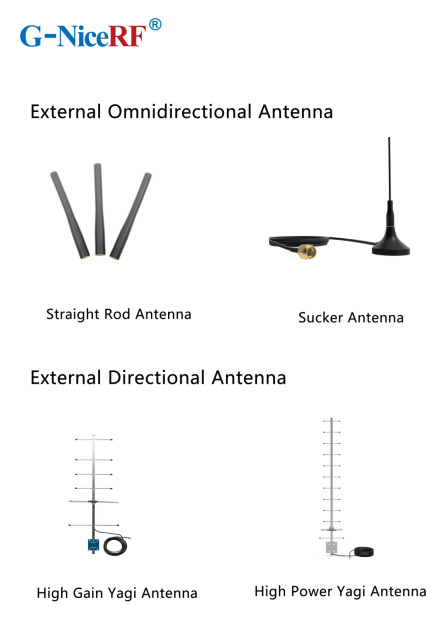
What are the main types of antennas?
External Antennas: These antennas can be classified into omnidirectional antennas and directional antennas based on the radiation pattern.
Internal Antennas: These antennas refer to antennas that can be placed inside devices.
Omnidirectional Antennas: These antennas radiate signals uniformly in the horizontal plane, making them suitable for applications that require 360-degree coverage, such as home Wi-Fi routers and mobile devices.
Directional Antennas: These antennas have a high emission and reception strength in one or more specific directions, while the strength is minimal or zero in others. Directional antennas are primarily used to enhance signal strength and improve interference resistance.
PCB Antennas: These antennas are directly printed on the circuit board and are suitable for devices with limited space, commonly used in small wireless modules and IoT devices.
FPC Antennas: FPC antennas are flexible printed circuit antennas that are lightweight, efficient, and easy to integrate.
Concealed Antennas: Designed for aesthetic purposes, concealed antennas can be hidden within devices or disguised as other objects, making them suitable for applications where appearance is important without compromising signal quality.
Antenna Selection Guide
When selecting the appropriate antenna for a communication module, it's essential to first determine whether to use an internal or external antenna based on the module's structure.
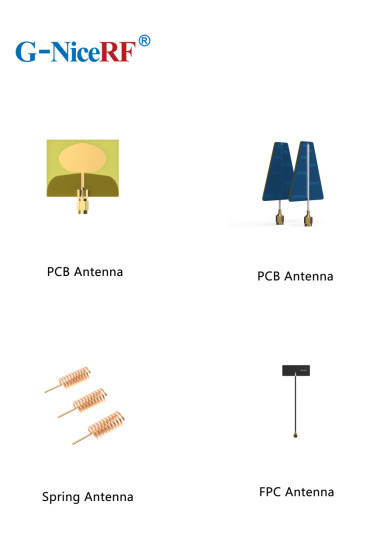
External Antennas: These antennas offer high gain, are less affected by the environment, and can save development time, but they may take up space and impact the product's aesthetics.
Internal Antennas: These have relatively high gain and are installed within the device, maintaining a clean and appealing exterior.
Sucker Antennas: These provide high gain and are easy to install and secure.
Copper Rod Sucker Antennas: Made from large-diameter pure copper radiators, these are highly efficient with a wide bandwidth.
Rubber Rod Antennas: Offer moderate gain at a low cost.
Fiberglass Antennas: Suitable for harsh environments and ideal for long-distance signal

External Directional Antennas
Typically used in environments with long communication distances, small signal coverage areas, and high target density.
Panel Antennas have high efficiency, are compact, and easy to install, while considering the impact of gain and radiation area Yagi Antennas offer very high gain, are slightly larger, and have strong directionality, making them suitable for long-distance signal transmission; however, attention must be paid to the antenna's orientation during use
Internal Antenna Selection
Most internal antennas are affected by environmental factors and may require custom design or impedance matching
Spring Antennas are cost-effective but have low gain and narrow bandwidth, often requiring tuning for good matching when installed Ceramic Patch Antennas occupy minimal space and perform well, but have a narrow bandwidth
For details, please click:https://www.nicerf.com/products/ Or click:https://nicerf.en.alibaba.com/productlist.html?spm=a2700.shop_index.88.4.1fec2b006JKUsd For consultation, please contact NiceRF (Email: [email protected]).
2 notes
·
View notes
Text
The People have spoken,
JermaTV is go. If anyone is interested/has technical questions feel free to ask but I’ll basically be modifying a composite TV RF modulator to be amplified slightly through an LNA board and out into a dummy load/highly non-efficient antenna. (I’ll play with power levels and see what the best output I can get is while following local regulations)
As far as what I’ll actually broadcast, please send me your favourite jerma moments™ and I’ll broadcast it on air / see if I could make a YouTube video out of it if you guys want.
#jerma#jerma tv#ham radio#amateur radio#amateurradio#amateur television#196#jerma985#electronics#electrical engineering
19 notes
·
View notes
Text
This FS1000A 433mHz Tx & Rx RF Module is a Compact, Economic and easy to use wireless RF module with both transmitter and receiver. The module operates at 433MHz and could communicate upto a range of 100 meters with proper antenna design. Practically with normal antenna it could cover distance of 20-50 meters. It can transmit at a speed of 1Kbps to 10Kbps and is easy to use with microcontrollers like Arduino, PIC, AVR etc..
5 notes
·
View notes
Text
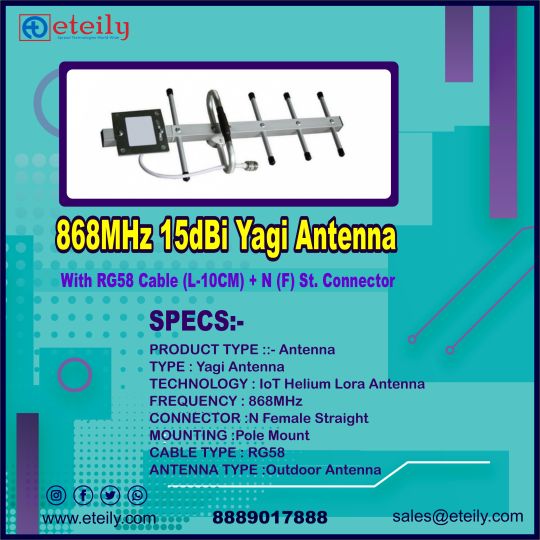
GSM 15dBi Yagi Antenna with RG58 Cable (L-10CM) + N (F) St. Connector
ETEILY Manufactures Yagi Antennas with good performance that comes handy, suitably working in all environment conditions.Our directional antennas are both suited for domestic as well as commercial applications.
Robust Mechanical design
High Gain
Good Signal Reception
Better Signal to Noise ratio
#Yagi–Uda antenna#Yagi antenna#Yagi beam antenna#rf antenna#RF Antennas#RF Antenna at Best Price in India#RF antenna system#radio frequency antenna#Best RF Solution Provider#RF Antenna Suppliers#Manufacturer of RF Antenna#rf antenna manufacturers in india#RF Antenna Manufacturer#RF Antenna Exporters#RF Antenna Latest Price#Wireless HF Antenna#RF Antenna Companies in India#Wholesaler of RF Antenna#RF Antenna Amplifier#RF Antenna Module#2.45 GHz Antenna Module#High Performance RF#Antennas for LoRa and Sigfox#Omni-directional SMD antennas#3.3GHz RF Antennas#RF & Microwave Antenna Manufacturers#Antenna manufacturers in Canada#RF Antenna manufacturers & suppliers - India#RF Antenna made in India#India telecom rf antenna
0 notes
Text
inventing new awful ways to watch tv by broadcasting youtube from a shitty rabbit ear antenna connected to an RF modulator
5K notes
·
View notes
Text
GaAs Wafer Market Size Powering Next-Gen Electronics with High-Performance Materials
The GaAs Wafer Market Size is experiencing robust growth, fueled by rising demand for high-speed, high-frequency devices across consumer electronics, aerospace, defense, and telecommunications. According to Market Size Research Future, the global gallium arsenide (GaAs) wafer market is projected to reach USD 1.5 billion by 2030, expanding at a CAGR of 12.4% during the forecast period (2023–2030).
Overview
Gallium arsenide wafers offer superior electronic performance over silicon, particularly in terms of speed, efficiency, and resistance to radiation. GaAs-based semiconductors are ideal for high-frequency, low-noise applications such as RF amplifiers, satellite communication, radar systems, and optoelectronic devices like LEDs and laser diodes.
With the surge in 5G rollout, satellite internet, and demand for high-speed data transmission, GaAs wafers are becoming essential in enabling these technologies. Their inherent material advantages—such as higher electron mobility and direct bandgap—make them indispensable for next-generation electronics.
Market Size Segmentation
By Product Type:
SI GaAs (Semi-Insulating)
SC GaAs (Semi-Conducting)
By Wafer Size:
2-inch
4-inch
6-inch
Others
By Application:
RF Electronics
Optoelectronics
Photovoltaic Cells
LED and Laser Diodes
Others
By End-User:
Aerospace & Defense
Telecommunications
Consumer Electronics
Automotive
Industrial
Others
By Region:
North America
Europe
Asia-Pacific
Latin America
Middle East & Africa
Market Size Trends
1. Rising Adoption in 5G Infrastructure
The deployment of 5G networks has increased the demand for high-performance RF front-end modules, where GaAs wafers are critical due to their high electron mobility and efficiency in millimeter-wave frequencies.
2. Miniaturization of Electronic Devices
As smartphones and wearable devices become more compact, GaAs wafers are being used to fabricate integrated circuits that deliver high performance in limited space without thermal compromise.
3. Increased Investment in Satellite Communication
GaAs technology is being extensively deployed in satellite transceivers and phased-array antennas due to its excellent power and frequency-handling characteristics.
4. Sustainability in Energy Systems
GaAs wafers are being investigated for use in high-efficiency photovoltaic cells for space-based and terrestrial applications, promoting greener energy alternatives.
Segment Insights
By Product Type:
SI GaAs wafers dominate the market owing to their superior resistivity and suitability for high-frequency analog applications like radar and satellite communication. SC GaAs, on the other hand, is gaining ground in optoelectronic applications.
By Wafer Size:
The 4-inch wafer segment holds the largest market share due to its compatibility with existing fabrication lines. However, the 6-inch segment is expected to grow rapidly as manufacturers strive to increase yield and reduce costs per chip.
By Application:
RF electronics account for the majority of GaAs wafer consumption, particularly in smartphones and wireless infrastructure. Optoelectronics such as LEDs, laser diodes, and photodetectors are a fast-growing segment due to rising demand in automotive and display technologies.
End-User Insights
Telecommunications:
This sector leads in GaAs wafer consumption for power amplifiers, switches, and filters used in mobile devices and telecom infrastructure.
Aerospace & Defense:
GaAs wafers play a crucial role in high-frequency radar systems, electronic warfare, and secure satellite communications.
Consumer Electronics:
Smartphones, tablets, and wearables integrate GaAs-based chips to support high-speed, low-latency connectivity and compact form factors.
Automotive:
Advanced driver-assistance systems (ADAS), infotainment, and LiDAR systems benefit from the reliability and efficiency of GaAs wafers.
Industrial:
Automation systems and sensors in manufacturing utilize GaAs devices for precision control and robust signal transmission in harsh environments.
Key Players
Key players in the GaAs wafer market are focusing on capacity expansion, technological innovation, and strategic partnerships to meet rising global demand:
Qorvo Inc. – A leader in RF solutions using GaAs technology for 5G, Wi-Fi, and defense systems.
Win Semiconductors Corp. – Offers GaAs foundry services for high-speed wireless and optical communication devices.
Advanced Wireless Semiconductor Company (AWSC) – Specializes in GaAs-based RFICs for smartphones and wireless networks.
AXT Inc. – Supplies raw GaAs substrates for various high-frequency applications.
IQE PLC – Provides GaAs epitaxial wafers used in wireless, photonics, and power electronics.
Sumitomo Electric Industries, Ltd. – Develops GaAs wafers for optical and RF semiconductor components.
Future Outlook
The GaAs wafer market is set to grow significantly over the next decade, driven by 5G expansion, increased satellite-based services, and growth in high-frequency device applications. Emerging areas such as augmented reality (AR), autonomous vehicles, and space exploration will further push the boundaries of GaAs adoption.
Ongoing research into large-diameter GaAs wafers and cost-effective manufacturing processes is expected to enhance scalability and commercial viability. Asia-Pacific, particularly China, Taiwan, and South Korea, is likely to dominate the market, backed by a strong electronics manufacturing ecosystem.
Trending Report Highlights
Explore adjacent technology markets and discover what's shaping the future of electronics and semiconductors:
Infrared Aerial Camera Market Size
LCD Panel Market Size
LED Tube Market Size
Odor Sensor Market Size
Seven Segment Display Market Size
Speakerphones Market Size
Flexible Hybrid Electronics Market Size
Datacenter Chip Market Size
Robotic Window Cleaners Market Size
Artificial Intelligence Sensor Market Size
Electric Vehicle Parts and Components Market Size
0 notes
Text
Twin Famicom (NES model by Sharp)
The Twin Famicom is a video game console system that was produced by Sharp Corporation in 1986 (Juli 1) and was only released in Japan. It is a licensed Nintendo product that combines the Famicom (NES) and the Famicom Disk System into a single piece of hardware.
The essential parts of the Twin Famicom include a 60-pin socket for Famicom cartridges and a socket for Disk System disk cards. The player could switch between the two media types with a switch – cassette "カセット" or disk "ディスク" The Twin Famicom is fully compatible with the NES and can handle accessories made for the NES (e.g. Beam Gun). But there is also an extra port on the Twin Famicom. This allows a 'regular' Famicom to use the Twin Famicom's disk drive.

The original Famicom only has one color combination, and the Twin Famicom was initially sold in two colors: red with black highlights (AN-500R), and black with red highlights (AN-500B). A second version of the system was released in 1987 with a slightly different case design, turbo controllers, and two different color schemes; black with green highlights (AN-505-BK) and red with beige highlights (AN-505-RD).
Like the Famicom, the Twin Famicom uses NTSC but with an AV output rather than an RF modulator[2][3] with an RCA connector for composite video and mono audio, allowing for greater audiovisual quality on TVs and monitors with such inputs. An external RF modulator is bundled with the unit for connection through a TV's antenna/cable input. The two gamepads are hardwired into the console, so they cannot be disconnected. Source: Wiki NES models Check these out too if you are interested in retro computing








24 notes
·
View notes
Text
Antenna in Package (AiP) Market Transformation Fueled by Millimeter-Wave and High-Frequency Applications
The Antenna in Package (AiP) Market is undergoing a transformative phase, driven by the rapid evolution of wireless communication, miniaturization of devices, and the widespread adoption of 5G technologies. AiP is an advanced packaging technology that integrates antenna elements directly within the package of a radio frequency (RF) front-end module. This eliminates the need for a separate antenna, significantly reducing the device footprint while improving performance. With the growing demand for compact, efficient, and high-speed wireless solutions across industries such as consumer electronics, automotive, and telecommunications, AiP is becoming a crucial enabler of next-generation applications.

Technological Advancements Driving the Market
One of the primary factors accelerating the AiP market growth is the increasing deployment of 5G infrastructure globally. AiP solutions are vital to mmWave (millimeter-wave) 5G technology, where higher frequencies are utilized to deliver ultra-fast data speeds. These frequencies require dense antenna arrays that can only be realized with compact and efficient integration techniques, which is precisely where AiP excels.
Additionally, the development of AI-driven smart devices and the Internet of Things (IoT) ecosystem has further pushed the boundaries for smaller, faster, and more energy-efficient antennas. AiP technology supports high-frequency operation and multi-band performance, making it ideal for multifunctional devices used in smart homes, autonomous vehicles, wearables, and industrial automation.
Expanding Applications Across Key Industries
The adoption of AiP is prominent in consumer electronics, particularly in smartphones, tablets, and laptops. Leading manufacturers are incorporating AiP modules to achieve sleeker designs while enhancing signal integrity. The automotive industry is also experiencing a significant impact from AiP integration, especially in advanced driver-assistance systems (ADAS) and vehicle-to-everything (V2X) communication, where reliable and compact antenna solutions are critical.
In the defense and aerospace sector, AiP is enabling robust and secure communication systems that meet stringent size, weight, and performance (SWaP) requirements. Furthermore, in the healthcare sector, AiP is facilitating the development of compact medical imaging and diagnostic devices with enhanced wireless connectivity, especially for remote monitoring and telemedicine applications.
Market Dynamics and Regional Insights
The global AiP market is expected to grow at a substantial CAGR over the next several years. North America currently leads in terms of revenue share, primarily due to early 5G rollouts, strong presence of leading tech companies, and significant investments in R&D. However, the Asia-Pacific region is projected to witness the fastest growth, driven by massive consumer electronics production, rising demand for advanced connectivity solutions, and increased government focus on smart city initiatives and digital transformation.
China, Japan, and South Korea are at the forefront of AiP adoption in Asia-Pacific, with Chinese manufacturers aggressively expanding 5G networks and launching AiP-enabled devices. Europe is also emerging as a strong player in the AiP space, supported by technological innovation and regulatory support for clean and connected mobility.
Key Players and Strategic Initiatives
Prominent players in the AiP market include Qualcomm, Murata Manufacturing, Amkor Technology, MediaTek, and Samsung Electronics. These companies are continuously investing in research and innovation to develop next-generation AiP modules that meet the demands of evolving wireless communication standards.
Strategic collaborations, partnerships, and mergers are shaping the competitive landscape. For instance, partnerships between semiconductor companies and telecom giants are accelerating the integration of AiP into 5G infrastructure. Moreover, increased venture capital funding in AiP startups is spurring innovation and commercialization of advanced packaging solutions.
Future Outlook
The future of the AiP market looks highly promising. With the rise of 6G research, augmented reality (AR), virtual reality (VR), and ubiquitous IoT connectivity, the demand for miniaturized, high-performance antennas will surge even further. AiP technology, with its ability to combine efficiency, compactness, and reliability, is poised to become the standard for next-generation wireless devices.
However, challenges such as high manufacturing costs, thermal management issues, and integration complexities remain. Overcoming these barriers will require collaborative efforts between technology providers, material scientists, and manufacturers.
In conclusion, the Antenna in Package (AiP) Market is at the heart of a wireless revolution, powering innovations across various industries. As technological trends evolve, AiP is set to redefine the standards of antenna performance, paving the way for a smarter, more connected future.
0 notes